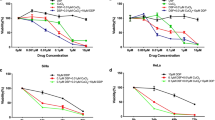Disulfiram (DSF), which is used to treat alcohol dependence, has been reported to have anticancer effects in various malignant tumors. We studied the anti-cancer effects and mechanism of action of DSF on cervical cancer cell lines HeLa and SiHa. The anti-cancer effects of DSF were confirmed in vivo using a xenograft tumor model. The anti-cancer effects of DSF in human head and neck squamous cell carcinoma were found to be copper (Cu)-dependent. The anti-tumor effects of DSF/Cu were time- and dose-dependent and were mediated by both autophagy and apoptosis. DSF/Cu shows stronger cytotoxicity to adenocarcinoma cell lines with higher malignant behavior, and valosin-containing protein (VCP) is its potential target. The cytotoxic effect of DSF/Cu against cervical cancer cell lines in vitro was mediated by apoptosis and autophagy simultaneously. Analysis of the clinical relevance of DSF/Cu on a xenograft animal model showed that DSF markedly stimulated tumor necrosis. DSF may contribute to improved survival of patients with cervical cancer. The antitumor characteristic of DSF can be used in the development of a new drug for advanced and refractory patients with cervical cancer.
Similar content being viewed by others
References
American College of Obstetricians and Gynecologists. ACOG practice bulletin. Diagnosis and treatment of cervical carcinomas. Number 35, May 2002. American College of Obstetricians and Gynecologists. Int. J. Gynaecol. Obstet. 2002;78(1):79-91. doi: 10.1016/s0020-7292(02)90092-5
Bray F, Ferlay J, Soerjomataram I, Siegel RL, Torre LA, Jemal A. Global cancer statistics 2018: GLOBOCAN estimates of incidence and mortality worldwide for 36 cancers in 185 countries. CA Cancer J. Clin. 2018;68(6):394-424. doi: https://doi.org/10.3322/caac.21492
Dufour P, Lang JM, Giron C, Duclos B, Haehnel P, Jaeck D, Jung JM, Oberling F. Sodium dithiocarb as adjuvant immunotherapy for high risk breast cancer: a randomized study. Biotherapy. 1993;6(1):9-12. doi: https://doi.org/10.1007/BF01877380
Faiman MD, Jensen JC, Lacoursiere RB. Elimination kinetics of disulfiram in alcoholics after single and repeated doses. Clin. Pharmacol. Ther. 1984;36(4):520-526. doi: https://doi.org/10.1038/clpt.1984.213
Iwashita H, Sakurai HT, Nagahora N, Ishiyama M, Shioji K, Sasamoto K, Okuma K, Shimizu S, Ueno Y. Small fluorescent molecules for monitoring autophagic flux. FEBS Lett. 2018;592(4):559-567. doi: https://doi.org/10.1002/1873-3468.12979
Jemal A, Bray F, Center MM, Ferlay J, Ward E, Forman D. Global cancer statistics. CA Cancer J. Clin. 2011;61(2):69-90. doi: https://doi.org/10.3322/caac.20107
Klussmann JP, Mooren JJ, Lehnen M, Claessen SM, Stenner M, Huebbers CU, Weissenborn SJ, Wedemeyer I, Preuss SF, Straetmans JM, Manni JJ, Hopman AH, Speel EJ. Genetic signatures of HPV-related and unrelated oropharyngeal carcinoma and their prognostic implications. Clin. Cancer Res. 2009;15(5):1779-1786. doi: https://doi.org/10.1158/1078-0432.CCR-08-1463
Lord CJ, Ashworth A. PARP inhibitors: Synthetic lethality in the clinic. Science. 2017;355:1152-1158. doi: https://doi.org/10.1126/science.aam7344
McMillin GA, Travis JJ, Hunt JW. Direct measurement of free copper in serum or plasma ultrafiltrate. Am. J. Clin. Pathol. 2009;131(2):160-165. doi: https://doi.org/10.1309/AJCP7Z9KBFINVGYF
Rodríguez AC, Schiffman M, Herrero R, Hildesheim A, Bratti C, Sherman ME, Solomon D, Guillén D, Alfaro M, Morales J, Hutchinson M, Katki H, Cheung L, Wacholder S, Burk RD. Longitudinal study of human papillomavirus persistence and cervical intraepithelial neoplasia grade 2/3: critical role of duration of infection. J. Natl Cancer Inst. 2010;102(5):315-324. doi: https://doi.org/10.1093/jnci/djq001
Safi R, Nelson ER, Chitneni SK, Franz KJ, George DJ, Zalutsky MR, McDonnell DP. Copper signaling axis as a target for prostate cancer therapeutics. Cancer Res. 2014;74(20):5819- 5831. doi: https://doi.org/10.1158/0008-5472.CAN-13-3527
Skrott Z, Mistrik M, Andersen KK, Friis S, Majera D, Gursky J, Ozdian T, Bartkova J, Turi Z, Moudry P, Kraus M, Michalova M, Vaclavkova J, Dzubak P, Vrobel I, Pouckova P, Sedlacek J, Miklovicova A, Kutt A, Li J, Mattova J, Driessen C, Dou QP, Olsen J, Hajduch M, Cvek B, Deshaies RJ, Bartek J. Alcohol-abuse drug disulfiram targets cancer via p97 segregase adaptor NPL4. Nature. 2017;552:194-199. doi: https://doi.org/10.1038/nature25016
Wang NN, Wang LH, Li Y, Fu SY, Xue X, Jia LN, Yuan XZ, Wang YT, Tang X, Yang JY, Wu CF. Targeting ALDH2 with disulfiram/copper reverses the resistance of cancer cells to microtubule inhibitors. Exp. Cell Res. 2018;362(1):72-82. doi: https://doi.org/10.1016/j.yexcr.2017.11.004
Yip NC, Fombon IS, Liu P, Brown S, Kannappan V, Armesilla AL, Xu B, Cassidy J, Darling JL, Wang W. Disulfiram modulated ROS-MAPK and NFκB pathways and targeted breast cancer cells with cancer stem cell-like properties. Br. J. Cancer. 2011;104(10):1564-1574. doi: https://doi.org/10.1038/bjc.2011.126
zur Hausen H. Papillomavirus infections — a major cause of human cancers. Biochim. Biophys. Acta. 1996;1288(2):F55- F78. doi: https://doi.org/10.1016/0304-419x(96)00020-0
Author information
Authors and Affiliations
Corresponding author
Additional information
Translated from Kletochnye Tekhnologii v Biologii i Meditsine, No. 4, pp. 238-245, December, 2021
Rights and permissions
About this article
Cite this article
Zhang, W., Zhai, Q., Li, M. et al. Anti-Cancer Effects of Disulfiram in Cervical Cancer Cell Lines Are Mediated by Both Autophagy and Apoptosis. Bull Exp Biol Med 172, 642–648 (2022). https://doi.org/10.1007/s10517-022-05447-w
Received:
Published:
Issue Date:
DOI: https://doi.org/10.1007/s10517-022-05447-w




